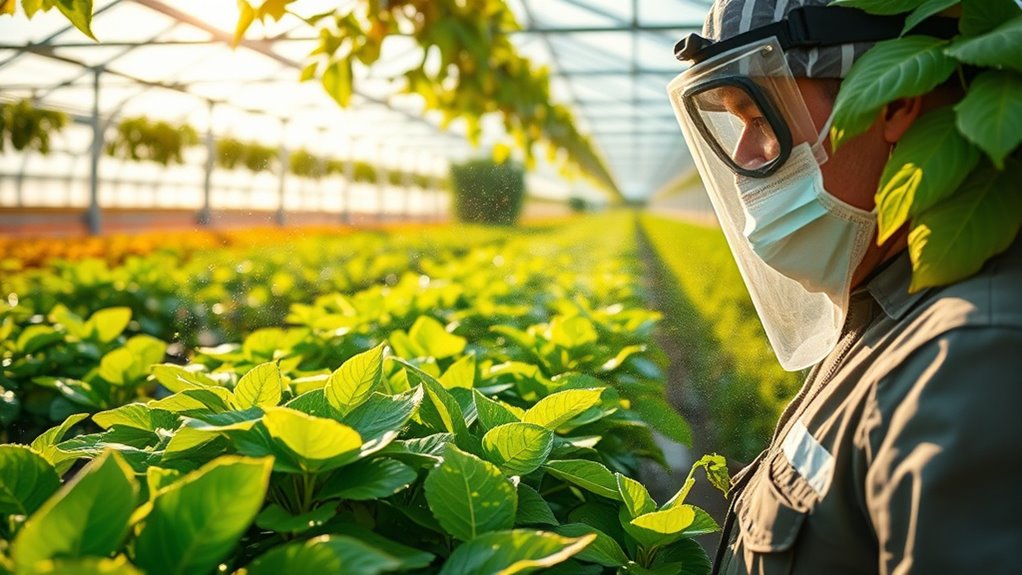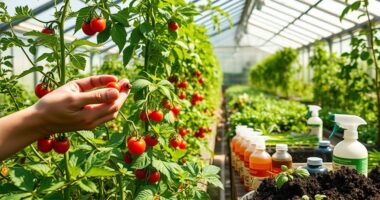To prevent Botrytis (gray mold) in your greenhouse, guarantee proper air circulation and ventilation to decrease humidity levels. Water plants early in the morning, prune regularly to improve airflow, and maintain adequate spacing between plants. Clean soil and sterilize tools after each use. If needed, consider fungicides from different groups or biological controls like Bacillus subtilis. Implementing these strategies can effectively manage the risk of gray mold and support healthy plant growth. Explore more effective methods for keeping your greenhouse safe.
Key Takeaways
- Ensure proper air circulation and ventilation to maintain low humidity levels in the greenhouse.
- Water plants directly into the soil during the morning to promote evaporation and reduce moisture.
- Regularly prune plants to improve airflow and remove any diseased parts promptly.
- Maintain adequate spacing between plants to enhance air movement and prevent humidity buildup.
- Implement sanitation measures, including cleaning soil and sterilizing tools, to limit Botrytis spread.
Understanding Botrytis and Its Impact on Greenhouses

When you're managing a greenhouse, it's crucial to understand Botrytis cinerea, the fungus responsible for gray mold, which can wreak havoc on your crops.
This fungus affects a wide range of plants, including ornamentals and vegetables, thriving in the controlled greenhouse environment. You might notice symptoms like leaf spots, flower blights, and bud rots, leading to significant economic losses if not addressed.
Botrytis can survive on organic matter and in soil, making sanitation a key preventive measure. It often infects plants through wounds, so careful handling is imperative.
Effective management involves integrated pest management strategies, including regular monitoring and early detection, to minimize the impact of this destructive fungus on your greenhouse operations.
Ideal Environmental Conditions for Botrytis Growth
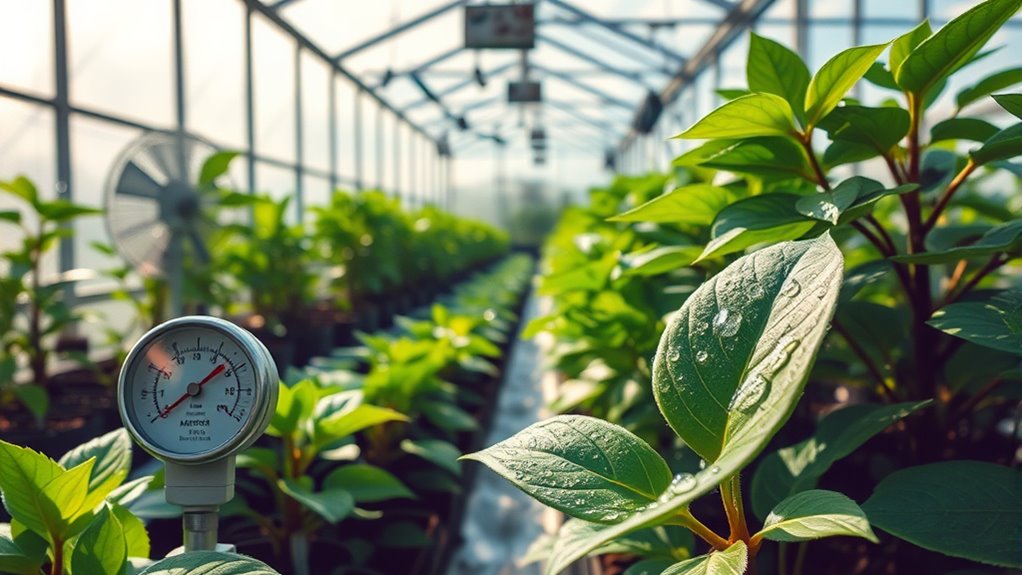
Botrytis cinerea thrives in specific environmental conditions that can easily be found in greenhouses.
It prefers temperatures between 65°F and 75°F, but can still infect plants at lower temperatures, ranging from 55°F to 65°F.
High humidity, particularly above 90%, greatly boosts infection risk, especially when moisture lingers on plant surfaces for 4-12 hours.
Sources like dew, rain, and overhead irrigation contribute to this moisture, while poor air circulation exacerbates the problem by trapping humidity.
Good air movement is essential for reducing moisture levels and preventing infections.
Preventive Measures Without Fungicides
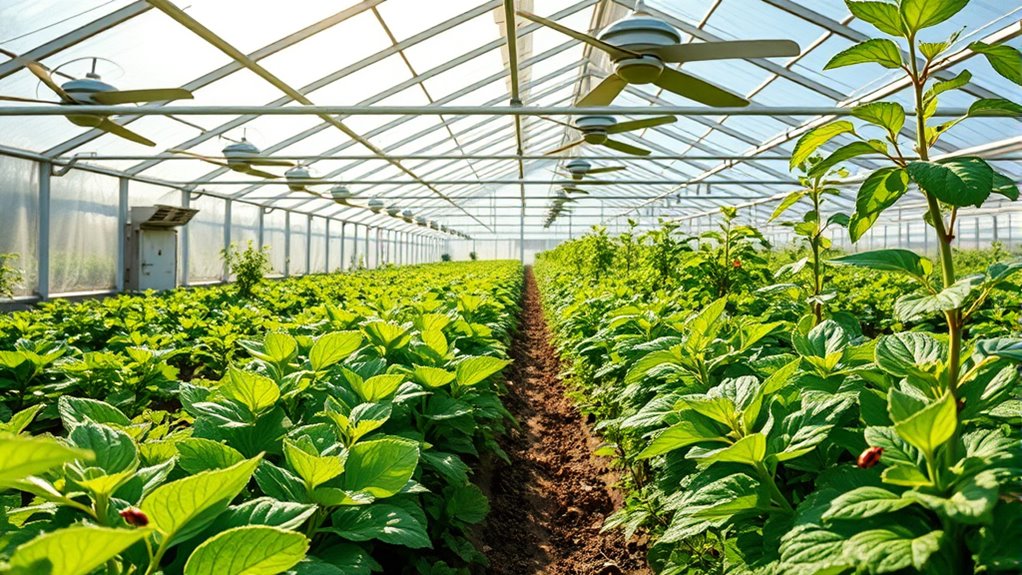
To effectively prevent Botrytis cinerea in your greenhouse, consider implementing a variety of preventive measures that don't rely on fungicides.
Start by ensuring proper air circulation and ventilation to minimize humidity, and use dehumidifiers to control moisture levels.
Water directly into the soil, ideally in the morning, to allow for evaporation during the day.
Prune your plants regularly to improve airflow and remove any diseased portions.
Maintain adequate spacing between plants to promote circulation and monitor your crops for early signs of disease.
Finally, keep the soil clean and free of debris, and make sure to sterilize your tools after each use to prevent the spread of spores.
Chemical Control Methods for Botrytis

While preventive measures are essential, chemical control methods can also play a significant role in managing Botrytis cinerea in your greenhouse.
To effectively combat this fungus, rotate fungicides from different FRAC groups, like chlorothalonil, iprodione, and mancozeb. Mixing protectant and systemic fungicides can enhance efficacy, but always check labels for crop safety to avoid damage.
Use fungicides preventively before symptoms appear, applying them no more than twice from any specific group to prevent resistance. Be cautious, as some products may discolor blooms or cause crop damage.
Finally, remember that fungicides won't substitute for good sanitation and environmental control—combine them with these practices for the best results.
Biological Control Methods for Gray Mold
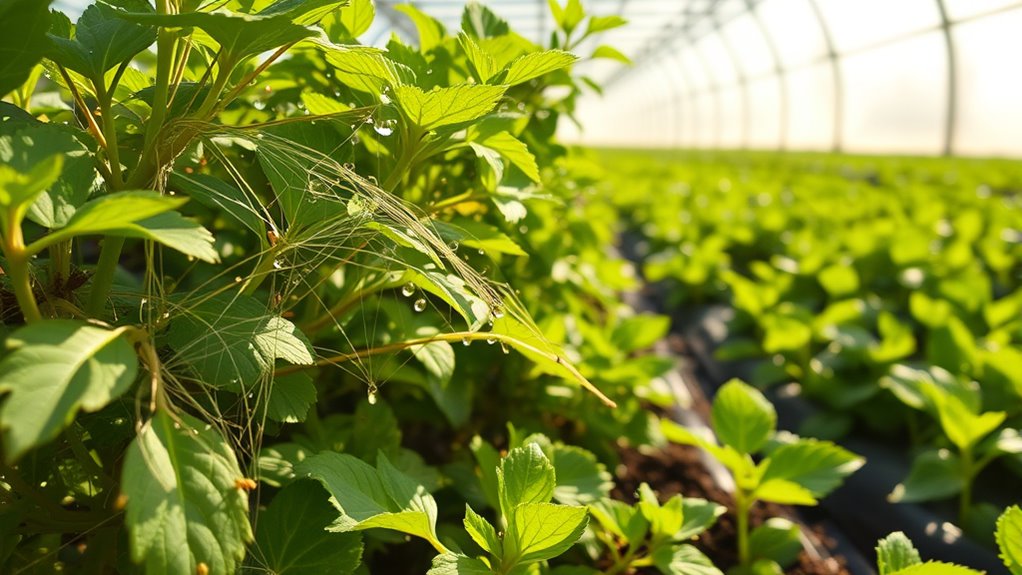
When managing gray mold in your greenhouse, biological control methods offer a sustainable alternative to chemical fungicides. You can utilize agents like Bacillus subtilis and Trichoderma harzianum to inhibit *Botrytis cinerea* through mechanisms such as antibiosis and hyperparasitism.
Other effective options include Streptomyces species and Ulocladium oudemansii, which compete for nutrients and space, enhancing plant resistance.
Apply these biocontrol agents as sprays or drenches, ideally before symptoms appear. They're safer for food crops and promote overall plant health.
While challenges exist, like varying efficacy, ongoing research aims to improve these methods. By integrating biological controls into your strategy, you can reduce reliance on chemicals and foster a more sustainable greenhouse environment.
Effective Greenhouse Design and Management Strategies
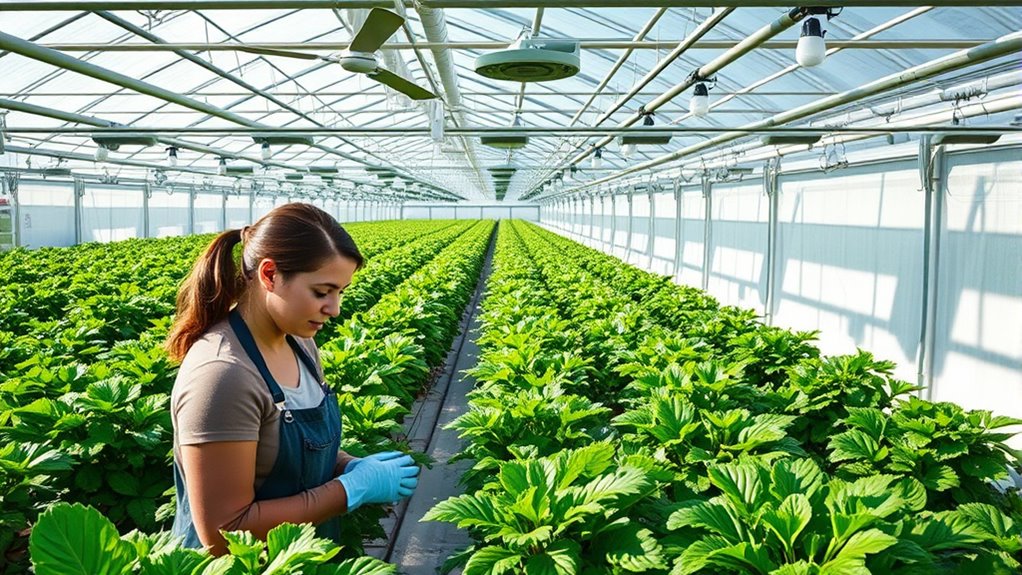
Integrating biological control methods into your greenhouse management is just one part of a larger strategy to combat gray mold effectively.
Start by positioning your greenhouse in a well-ventilated area, avoiding shaded spots that trap moisture. Opt for taller structures with large windows to enhance airflow.
Maintain temperatures between 17°C and 23°C while keeping humidity below 85% to inhibit fungal growth. Use drip irrigation to keep plant canopies dry and water at the base to reduce leaf moisture.
Regularly clean your greenhouse, disinfect tools, and remove debris to minimize fungal spores.
Finally, guarantee adequate plant spacing and monitor plant health to catch issues early. These design and management strategies will greatly reduce your risk of gray mold.
Frequently Asked Questions
Can Botrytis Affect Vegetables as Well as Ornamental Plants?
Yes, Botrytis can definitely affect both vegetables and ornamental plants.
It targets a wide range of crops, including artichokes, leafy greens, and solanaceae. You'll notice symptoms like gray or brown spots on leaves and fruits, along with fuzzy growth under high humidity.
To minimize risk, keep your plants healthy and avoid overcrowding.
How Can I Identify Botrytis Early on My Plants?
How can you spot Botrytis before it wreaks havoc on your plants?
Look for initial signs like white growth that darkens to gray, soft and brown tissue, and fuzzy spores forming in humid conditions.
Pay close attention to leaves, stems, and flowers, especially where there's damage or moisture.
Remember, the sooner you identify these symptoms, the better chance you have to protect your plants from serious infection.
Stay vigilant and act quickly!
What Are the Economic Impacts of Botrytis on Greenhouse Production?
Botrytis can seriously impact your greenhouse production economically. You might experience reduced crop yields and face post-harvest quality issues, leading to lower market prices or rejected products.
Managing this disease often requires additional resources for sanitation and fungicides, increasing your production costs. With fungicide resistance emerging, finding effective alternatives becomes vital.
Ultimately, the financial implications can ripple through your operations, affecting sustainability and profitability.
Are Some Plant Varieties More Resistant to Botrytis?
Absolutely, some plant varieties are more resistant to Botrytis than others.
Imagine strolling through a garden, where vibrant peonies and sturdy lisianthus bloom without a care. You'll find that tree peonies and 'Magic Champagne' lisianthus stand strong against disease.
How Does Climate Change Affect Botrytis Outbreaks in Greenhouses?
Climate change considerably affects Botrytis outbreaks in greenhouses.
You'll notice that rising temperatures and increased humidity create ideal conditions for the fungus to thrive. As you manage your plants, be aware that these changes might lead to more virulent strains developing.
Additionally, stress from climate shifts can make your plants more susceptible to infections. Keeping an eye on the weather and adjusting your greenhouse conditions can help mitigate these risks.
Conclusion
To keep Botrytis at bay, you need to stay proactive in your greenhouse management. Did you know that over 30% of crops can be lost to gray mold if left unchecked? By understanding the conditions that favor its growth and implementing preventive measures, you can greatly reduce the risk. Embrace biological and chemical controls when necessary, and design your greenhouse thoughtfully. By doing so, you'll protect your plants and increase your yields, ensuring a thriving growing environment.
